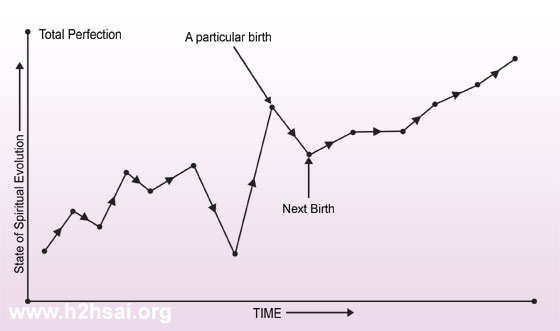-
IN QUEST OF INFINITY –30
Recap from the Last Issue
Loving Sai Ram and greetings from Prashanti Nilayam. Towards the end of the last issue, I made an observation that could be restated as follows:
In short, there is INFINITY all by itself, and the Jivatma (an individual) representing an embodiment of this INFINITY, exists in the finite Universe created by God [read INFINITY]. The Jivatma constantly deals with the abstract INFINITY in some manner or the other; however, due to Spiritual ignorance, the Jivatma does not know about this and thus misses the INFINITY that is embedded or immanent in every single entity of the finite Universe. In short, it is a case of INFINITY hiding in every nook and corner of the FINITE Universe! Amazing, it is not?
It is Vedanta that links all these, and maybe I shall try and say something about these complex topics later. But meanwhile, I do hope you appreciate that in order to discuss INFINITY, we first have to do it in terms of OUTSIDE and INSIDE and then show that there really is not two but just one, just as when one gets out of a car, there is no front and back in the sense there was when one was inside the car!
God, the Universe and the Gunas
 |
|
Fig. 1 |
In this instalment, I want to lead off from the above paragraph, which I shall do with the help of some comments and graphics. Let me start with the obvious fact that while all of us are a part of Creation, we know that God/Atma can exist all by itself.
Thus, let us start with that situation where Atma alone is, i.e., there is no Universe. This is symbolised in part (a) of Fig 1 below. God then wills, and the Universe is born, which, in scientific terms, means the birth of Space and Time. This is shown in (b) symbolically.
Turn now to (c) which shows Space-Time with a tint. What is this tint and why is it there? Here is where I have to bring in a bit of Vedanta. Basically, the tint symbolises the fact that in the Vedantic picture, Gunas exist in Creation.
Gunas are an important part of the story, and I trust you know what they mean. Basically, it is they that give rise to diversity, which exists both in the inanimate and animate aspects of Creation.
At the inanimate level, one might say that it is due to the Gunas we have the various elements [and thus molecules, etc.]. At the animate level where we deal with living entities and species, Gunas are manifested via behavioural traits.
Thus, a tiger is ferocious while a rabbit is gentle. Please keep all this in mind and carefully study Fig. 1, after which please turn to Fig 2.
Fig. 1: This figure is a schematic in three parts intended to illustrate certain aspects associated with Creation. (a) shows the Abstract and Formless God all by Himself [there is just Oneness]. (b) shows the Abstract God PLUS the Universe consisting of only Space and Time. (c) shows Guna [represented by a grid overlapping Space and Time] superposed on Space and Time, which leads to diversity, an essential characteristic of Creation.
How our Body, Mind and Atma Have Dissimilar Roles in Creation
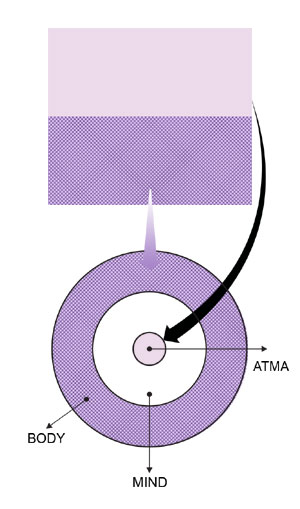 |
|
Fig. 2 |
Figure 2 is presented below, and in studying it, we have to keep in mind the fact that according to Vedanta, an individual is really an embodiment of the Atma [which, let us not forget, is just another name for God]. What exactly is the composition of this embodiment? That we have discussed earlier; basically, a human being is a composite of a gross body, a subtle Mind and the Causal Atma. In Fig. 2, we see [schematically of course] the relationship between God and Creation on the one hand, and the embodied individual (or the Jivatma as Vedanta refers to the person) on the other.
From the figure it is evident where the body and the Atmic component of the individual originate. What about the Mind? This is a slightly tricky question and the answer is to be found partly in Fig. 3. Basically, this figure shows [once again we stress that the representation is purely schematic] the Jivatma being born again and again. In this process of repeated births and deaths, the following facts need to be noted:
- With every death, the body is returned to the elements.
- In the next birth, there is of course a new body, which comes via new parents. Nevertheless, the atoms that make up the body come from the same Universe. A minor and perhaps obvious point, but worth noting.
- As for the Atma, it is always the same; that HAS to be so, by definition!
- OK, from birth to birth, the body is different while the Atmic aspect is invariant. What happens to the Mind? Does it vary from birth to birth, or is it utterly unchanging all the way through, or is it a bit of both? Which of the above is true?
Fig. 2: This figure is an elaboration of Fig. 1, and shows the Jivatma existing as a part of Creation. The Jivatma is made up of three distinct entities, the gross body, the Subtle Mind, and the Causal Atma. The gross body [derived from parents] is actually made up of atoms and molecules which really form a part of the entire Physical Universe; in that sense, the body is actually linked to the entire Universe, all the way to the Big Bang one might say! The [embodied ‘portion’ of the] Atma, on the other hand, is directly derived from Abstract God. It is thus NOT a part of Creation; rather, it transcends it, an important fact. This leaves the issue of the Mind, which is discussed later in the text.
From God you have come and to God you must go back. Sadhana is the process that facilitates this, and if you forget that aspect while going through all kinds of text book drills, then you are not progressing at all. |
This question can be rephrased somewhat differently, in order to dramatise the issue. The gross body has genes that come from our parents and ancestors [in fact, one could even trace parts of the gene to species that existed long before humans appeared]. OK, that takes care of the “body genes”.
The Mind and its Genes
What about the Atmic component of the Jivatma? This we can call the “Divine Gene” since it is directly related to God/Atma. This leaves the Mind, and the question now becomes: “Does the Mind have any genes, and if so, where do they come from?” I am raising this question in order to link it to the opening paragraph [which would be done later].
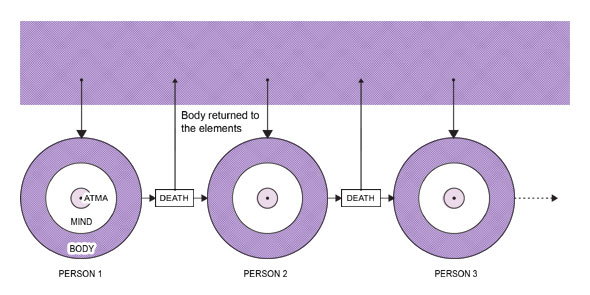 |
Fig. 3 : This figure captures the essence of the changes that the Jivatma undergoes from one birth to the next. At the time of death [of a particular being], the gross body is returned to the elements, while the Mind, along with the ‘embodied or trapped’ Atma goes adrift and seeks a new body to enter. In other words, the Mind-Atma complex derived from the previous birth now joins up with a new body derived from new parents, and that is what rebirth is all about. Thus the “new Mind” is, at start, a mere residue of the “old Mind” belonging to the earlier birth. Naturally, the “new Mind” has the “excess” baggage [the burden of sins as well as the gains associated with the merit accumulated in earlier birth]. These tendencies acquired in the earlier birth and which come along into the new life are called Vasanas and will be discussed further in the text.
It turns out that like the Atmic component and the gross body, both of which have “genes” of their own, the Mind too has what we might call “Mental Genes’, although Vedanta has a different name which is vasana. In short, Vasana is the latent behavioural tendencies a human is born with.
Let me now explain all this in some more detail, so that you understand better what I am trying to say. Say a baby is born. There can be no question that at the moment of birth, the baby is perfectly innocent; common sense tells us that it simply cannot be any other way. Yet, by the time the kid is say one year old, you begin to see some tendencies. Some babies tend to be aggressive, some cling to momma all the time, some are quite possessive and fiercely cling to their toys for example, some are wonderfully sweet and so on. Why this difference? Vedanta says it is all because of the Vasanas.
The Impact of Nature and Nurture
A simple way of understanding this [in fact this analogy has been given by Swami Himself] is to consider a seed that is planted in the ground. Suppose one examines what has happened, say after one year. Depending on a number of factors, one could see many things. If, for example, the seed has not been properly watered, the growth might be poor. Likewise, if there is no tree-guard, the tender leaves emerging from the plant might have been eaten by passing goats thus preventing growth. Similarly, due to lack of attention by the person who planted the seed, the tender plant might have been attacked by pests of various kinds; and so on, the list goes.
God is One, but when He expresses Himself via the entities in the Physical Universe, you would see nothing but diversity if your perception is entirely via the senses. On the other hand, if you choose to rise above the senses [which CAN be done], then the bewildering diversity suddenly collapses into a wonderful and utterly blissful Cosmic Oneness which is the true manifestation of the Abstract God. |
What this example highlights is the following:
- The plant that emerges from the seed would [obviously] be of the same species as what the seed belonged to.
- The actual state of the sapling would be determined by various environmental factors, as well as how it was taken care of.
In the same way, the Vasanas one is born with represent what a mathematician would call “initial conditions”. When the new-born baby is tiny, the Vasanas are latent and do not show up clearly. But then, as we all know, babies grow up very rapidly and while they do, they are all the time watching the external world. That is when the latent Vasanas slowly begin to surface and manifest as behavioural tendencies in the child. And that also is when the external influences begin to play a critical role. It could be the way the parents treat the child, and the environment the child is placed in. For example, if the parents are constantly quarrelling, then that would have an influence on the child. On the other hand, if the parents are loving and respectful to each other as well as to elders, then that has its own impact. Similarly, if the parents do not make the kid see TV all the time by way of keeping it engaged, but instead give it some quality time plus plenty of love and parental affection, then that too would have its own positive impact. This is where the analogy of caring for a tender plant and protecting it from goats, etc., becomes relevant. I am sure you get the general idea.
The net outcome of all this is, that due to the combined impact of the Vasanas [which, remember represent the initial conditions], and the environment in which the child grows, its tendencies in the present birth begin to assert themselves. An easy way to summarise all this is to draw a “graph of Spiritual progress of the Jivatma through the various births”. This is done below in Fig. 4 which should be easy to understand.
|
|
Fig. 4 |
Fig. 4: This figure is a schematic plot of what might be called the Spiritual State of the Jivatama as it goes through birth after birth [here, every dot marks the beginning of a new life]. Clearly, depending on the Vasanas at birth and the environment to which it is exposed, in every life, there is a chance either to become better on the whole, or become worse than at the start of the birth. There is thus a fluctuation, rather like in the stock market!
The fluctuations in the above figure remind you of stock market fluctuations, do they not? Indeed, life is like that. Depending on the Vasanas the Jivatma brings to a particular birth [the initial conditions for that particular birth], the environment it faces in that birth and also the Sadhana it manages to put in, the “Spiritual state” could go up or down.
No End in Sight…?
Staying on this theme just for a minute more, the question arises: “Is there no end to this? Is the Jivatma condemned to go through life after life with its fortunes fluctuating like in a snakes and ladders game? Is there no escape?” Stated that way, I am sure the question does ring a bell; at any rate, it should for that is precisely one of the questions that Adi Shankara asks in the course of his famous hymn Bhaja Govindam. I am not going to recall that at this juncture, leaving it to you as homework! But let me remind you that on October 20, 1940, when our beloved Swami made His famous declaration that He was Shirdi Sai come again as Sri Sathya Sai, He in fact gave an answer to this very question through His Bhajan: Manasa Bhajare Guru Charanam..... I hope at least that would help you to appreciate the answer to the question we have been discussing.
Connecting Infinity Within And Infinity Without
Let me move on and now try to link all that I have said thus far to the quote I presented at the beginning, which is really an extract from the last issue. The point is really this: Every time the Jivatma [that’s really you and me!] takes birth, there is Infinity within [the Atmic aspect that forms the core of our total personality], and Infinity without, not directly visible but certainly immanent and ours to experience, if only we care to make the effort. So there is this “Infinity within”, and the “Infinity without” [the two are really ONE but for operational and pedagogic reasons I consider them as “two entities”; please bear that caveat in mind], which means we [who really have Infinity within us] are also immersed in Infinity at the same time! And yet we go through life after life, totally oblivious to this critical fact, which goes a long way to obstruct our Spiritual evolution, which [i.e., Spiritual evolution], by the way, is the real purpose of life.
Swami reminds us: “From God you have come and to God you must go back. Sadhana is the process that facilitates this, and if you forget that aspect while going through all kinds of text book drills, then you are not progressing at all.” |
Just to remind you, Swami says that the human form is given so that we can go back to God. He reminds us: “From God you have come and to God you must go back. Sadhana is the process that facilitates this, and if you forget that aspect while going through all kinds of text book drills, then you are not progressing at all.” Swami further stresses that God in His Supreme mercy and kindness blesses us with the human form precisely for this purpose, and not “for having a ball”, the current mantra heavily marketed by vested interests through a well-fed media. To put it simply, going back to God, experiencing Infinity everywhere, doing real Sadhana, all tie up very intimately, if only we spend some time thinking about it, instead of spending it on e-mailing unnecessarily, twittering, and what have you. It is not for nothing that Swami says: Jantuunam Nara Janmam Durlabham, meaning that birth having the human form is rare and precious.
I now wish to spend a few moments discussing this business of seeing Infinity without, after which, I shall attempt to connect it to seeing Infinity within. That would then help me to explain that these “two Infinities” are in fact seamlessly connected; rather, on closer examination, they are not merely connected but in fact JUST ONE AND THE SAME! Let me see if I have luck with this ambitious program I have set for myself!
I shall start with the fact I have stated many times before which is that the Physical Universe we are in is FINITE. That is a scientific fact, and none of us can do anything about that. So the question can be asked: “What on earth do you mean by seeing Infinity in the world outside, which you yourself assert is finite?” A good question, and it actually has an answer; and I shall attempt to sketch that answer by recalling some experiences of my own [you might be disappointed when you read about these experiences but nevertheless I shall go ahead!].
The Glorious Variety Exhibited by Nature
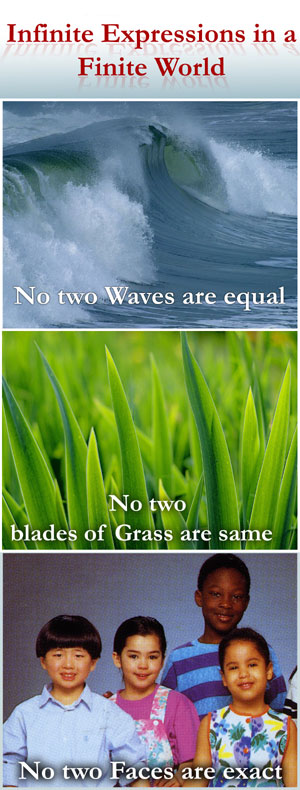 |
|
I do not exactly recall the year now, but I think it was perhaps 2003. Swami went to Brindavan a bit “early” which means before the end of the academic year, which invariably happens on March 31. Every morning, a few of us would gather in front of Trayee Brindavan to await Swami coming out for Darshan, and during the wait, every day I used to observe two things; the first was the beautiful lawn in front and the second was a wonderful and majestic peepul tree at the back, close to the boundary wall.
Let me start with the lawn first. It was of course, beautiful, fresh, nicely mowed, and all that. I like greenery and I would spend a lot of time just admiring the lawn and its beauty. I would then start looking closely at the individual blades of grass. I saw the same thing day after day, but somehow I could never stop wondering how no two blades of grass were ever alike. You know, that is really true! If you go around Cambridge, England, you see absolutely wonderful lawns in the various colleges, hundreds of years old in fact, but no two blades of grass are ever identical.
You may wonder: “What’s the big deal about this? In fact, it is trivial and utterly elementary. Has this guy gone bananas or something?” You may have a point but let me tell you what I think the big deal is. The big deal is that ordinary, simple, “common-garden” grass actually exhibits Infinite variety in a finite world! In other words, Infinity CAN give expression to itself in a finite world! I am sure most of you would be hardly impressed; but I ask you to bear with me and come to, say a beach. Just park yourself there, and watch with some patience, the waves repeatedly crashing on the shores. You can watch for hours and hours and you would find that no two waves are ever identical! There again you see a subtle manifestation of Infinity in a FINITE world.
You may shake your head and really believe that I have gone bonkers. Hold on for a minute; at least you would agree that the waves look beautiful, wouldn’t you? You would similarly agree that these things I am talking about are waves; that their composition is just salt water, as is that of the foam spray that usually is seen with big waves, and that lastly, water is what the ocean itself is made up of. I know you are getting increasingly impatient, but please do give me a few minutes more to make my case!
Let us now try and put all these things together, and enquire a bit deeply into all this. Let us start with the form of the waves that constantly lash on the shore. The variation is infinite. This infinite variation that is an integral part of our physical Universe is a reflection of the DIVERSITY that is an essential feature of Creation.
In this context, here are a few important points which you may kindly note.
Diversity is the essential nature of the Physical Universe.
Diversity can express itself in a variety of ways, technically infinite!
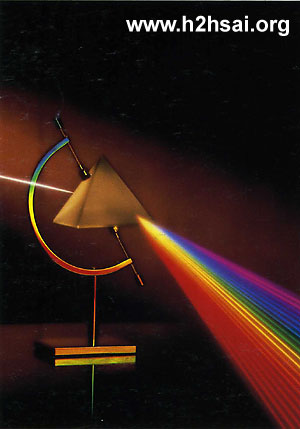 |
||
FIG. 5. |
In fact, while discussing the state of a physical system, physicists use the term entropy to characterise this diversity, and it is a law of Nature that under certain conditions, Nature likes to seek a state where entropy is a maximum [which, in physicist’s lingo, would translate as maximum diversity].
Oneness and Diversity – Two Sides of the Same Coin
Keeping all this in mind, let us go back to the waves, the foam spray, and the ocean as a whole. You will agree that they all contain the same salt water. While the foam spray and the waves readily exhibit the diversity they are capable of, the ocean seems one whole. In fact, if you go on an ocean liner, you would think [unless you study carefully] that all oceans look alike; and if you are a cynic, you might even say, “If you’ve seen one, you’ve seen’em all!”
If you reflect calmly on what I have just said, you would realise that diversity and Oneness are really two aspects of the same coin. That might sound a bit puzzling but just consider the schematic below in Fig. 5 which shows white light being split into the familiar seven colours VIBGYOR, which every school kid knows about.
The question arises: “Is the light white or does it have seven colours?” The answer of course is that whiteness as well as seven colours are both two aspects of the SAME light and everything depends on which side of the prism one is at.
FIG. 5: This schematic shows the familiar splitting of sunlight into seven colours, when the light is passed through a prism. If the question is asked: “Is sunlight white or made up of seven colours?” The answer would clearly depend on which side of the prism the observer is. From a general point of view, the answer is not one of “either-or” but “both”! That also is the viewpoint of Vedanta. Western science, which guides much of modern thought, always focuses on an “either/or” approach whereas Vedanta always says: “This and that!” which tends to be confusing. What Vedanta teaches is that if you see superficially it might seem to be “this”; however, if you examine carefully, what you imagine as “this” is really “that”! This schema is meant mainly to help you through that puzzling statement!
The True Experience Beyond the Senses
If we put all this together, we get the core statement of Vedanta, which is:
God is One, but when He expresses Himself via the entities in the Physical Universe, you would see nothing but diversity if your perception is entirely via the senses. On the other hand, if you choose to rise above the senses [which CAN be done], then the bewildering diversity suddenly collapses into a wonderful and utterly blissful Cosmic Oneness which is the true manifestation of the Abstract God.
In simple terms, the Abstract God makes Himself visible via diversity and the various amazing properties, features, etc., which these diverse entities exhibit in the physical world [like the beauty of the peacock, the power of a hurricane, the majesty of a mountain, and so on]. This is what is available to us via sense perception, all the time and absolutely free. If we choose to restrict ourselves merely to superficial sense perception, then the story ends here. There are only waves and foam, and the ocean does not catch the eye, though it is there in the background and is in fact the source of both the waves as well as the foam.
 |
EXPERIENCING the Infinity that lies beyond the perceived diversity |
The Wise One, on the other hand, is not satisfied with the restricted perception that the “seen” provides and wants to understand what is behind it all. He meditates and when he does so, he EXPERIENCES the Infinity that lies beyond the perceived diversity.
That is why Vedanta always stresses that behind the seen lies the UNSEEN, which is the TRUE REALITY. Swami too calls attention to this often, and did so frequently in the old days.
The Intelligence Behind Nature
Let me now make a quick reference to the Peepul tree which I mentioned earlier. When we arrived in Brindavan that year, this tree had shed all its leaves, as happens at that time of the year. And as I kept looking at that tree every morning, slowly the leaves started appearing. At first, there were just a handful of leaves scattered across the huge tree; but very quickly the number rose, until within two weeks or so, the tree had a full covering and began to look very beautiful with its crop of fresh and shining leaves.
Every morning I would gaze at that tree and wonder. The appearance of fresh leaves was, of course, a pretty routine thing that happens to hundreds of thousands of such trees at that time of the year. We often pass such trees as we hurry here and there, hardly ever noticing them. But that year, I had to do some waiting every morning and there was some time available to look at something which I would otherwise have not bothered to at all. Of course I always spent time admiring and enjoying the beauty, but I also spent some time pondering. What never failed to fill me with wonder was the following thought.
 |
Day after day I would say to myself: “This tree has no central nervous system, a brain and all that. Yet, something somewhere within this tree makes sure that the same amount of water and nutrition reaches all the leaves for they were all of the same size and looking equally healthy, shall I say. I mean, some leaves were close to the ground while others were far away, close to the top. And yet, they all seemed to know where exactly to grow like a bunch of soldiers falling in during parade. Furthermore, the leaves have to have access to sunlight to do the job they are supposed to, and it appeared that every leaf had positioned itself so that it was exposed quite well and got its quota; one more bit of wonder in Nature! Who manages all this, and where is that managing agency?
I know that to a biologist or one who is a devotee of Richard Dawkins, this might seem rather stupid, but my mind invariably went to Chapter Ten in the Gita, where Krishna explains to a stunned Arjuna how God plays hide and seek in the Universe. Yes, there are many wonders between heaven and earth that we are scarcely aware of, or care to know about in the midst of our busy schedule of e-mailing, browsing, twittering, and what not.
Fundamental Discrimination is the Key
I am sure most of you must have heard Swami refer to Discrimination or Fundamental Discrimination [FD], to be more precise. Simply put, FD is all about distinguishing the unreal from the Real, and the transient from the Eternal. Swami adds that we would be able to cultivate FD only by first learning to cognise the Infinity within. Once we do that and then begin to look at the “wide world outside”, it would be like throwing the prism away to look at sunlight, when we would see only “one colour”. In Spiritual language, we would be “experiencing” the world around us from a level beyond the senses and the Mind, thus zeroing in on the “Infinity outside”.
In short, the Golden Formula is:
Step 1: Seek Infinity within.
Step 2: See the “outside” from that perspective. That would then expose the “Infinity without”.
Step 3: Reflect, whereupon you would realise there are no two separate Infinities but just one. In Swami’s language, Truth is not two but just ONE!
I guess along the line somewhere, I must have referred to Stephen Weinberg’s remark about the Universe seeming to have no purpose. That is not true. The purpose of the Universe is to present to humans a platform where they can seek their true identity and then realise their oneness with God! Remember Swami saying: “I separated Myself from Myself, in order to Love Myself!”? All the above would, I hope, help you to “decode” that powerful statement! Give it a try anyway!
To get back to what I was saying, in short, first Seek Infinity within, then realise that you are that Infinity, and finally understand that there is only Infinity and nothing else!
The Parting Words in our Quest for Infinity
.jpg) |
But what about the diversity around us? Well, why don’t I leave that question to you to answer, while I say goodbye and thank you for being with me for such a long time? It has been a fairly long and extended trip we have had together, and I do hope that at the end of it all you did get something out of it. In case you have not, let me give it in a nutshell via two points that Swami makes, very crucial and central points, I might add.
POINT 1: This Swami makes it in the Gitavahini where He says [effectively]:
Life is essentially made up of actions, the need for action being determined by the circumstances one is placed in. However, while worldly considerations might dictate the need for actions, their basis must NOT be worldly consideration alone. Rather, they must be governed by ETERNAL CONSIDERATIONS.
In practical terms, what the above means is that our actions must be rooted in Sathya, Dharma, Prema, etc. To put it differently, actions must always be guided by a Moral Compass, which is another way of saying Atmic considerations. It is in that context, that knowing one’s True Self or cognising the Atma [read INFINITY] within becomes important.
POINT 2: The second point is closely related to the above in terms of practical decision making. Where action is actually concerned, the battle-field commander is the Mind. And by its very nature, the Mind would tend to be pulled towards the side of the world. To prevent that from happening, the HQ [meaning the Heart] must send out strong messages, conveyed through the pipeline called Buddhi. If the pipeline is blocked then the Mind does not get the orders from above, whereupon it starts improvising its own strategy based on worldly considerations alone. The role played by Buddhi has been extensively commented upon by Swami in earlier years. In simple terms, it all boils down to exercising proper discrimination, i.e., making the proper choice. Here again, Swami says that while deciding what to do, one must not be guided purely by worldly considerations but by Eternal considerations. If you recall, that was Arjuna’s problem in the battle field.
After itching for a fight for a long time, at the last minute he says he wants to quit. Why? Because war would mean killing Grandpa, Guru, etc. That is when Krishna asks, “Arjuna, you have fought battles many times before and also killed many in these encounters. Whatever happened to all this reasoning then? You did not cry then but are beginning to do so now, even before all these people have died. Why? Why Arjuna, why? I will tell you! This time, the ones who are going to die would be yours! So, your decision not to fight is based on bodily attachments!”
No matter where you start, once you start going round a circle, you would always end at the starting point! In fact, the circle is nothing but an infinite set of points, all infinitely close together and laid out as a circle! |
That is when Krishna asks Arjuna to look within and discover that he is in fact the Atma. Next, He says that when you fight, remember that it is only a conflict between bodies and that while bodies may die and perish, the Atma would be least affected. Thus, war and duty are the context Krishna uses to remind Arjuna how to look for INFINITY within and without, and link the two! Over here, we did it in a very different and rather roundabout manner, via a journey through the Cosmos first. I did this deliberately, mainly to highlight the fact that no matter where you start, once you start going round a circle, you would always end at the starting point! In fact, the circle is nothing but an infinite set of points, all infinitely close together and laid out as a circle!
I don’t think I have any right to confuse you further and so I shall really stop!
Thank you one and all, and all the best. And thank you too H2H, for patiently carrying all the stuff I had to hurriedly crank out during the last week of every month, and for putting up with the occasional default!
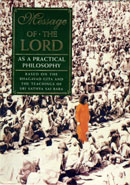 |
P.S: For your convenience, I have requested the Editor to make available as a PDF, Chapter 1 of the last part of the book MESSAGE OF THE LORD [available in our book store]. This book was written many years ago by me, but for reasons explained there, I did not put my name as the author. Please Click here to read the PDF.
A number of you have been sending me very good questions but since they were rather technical, I did not seek to answer them in the course of this current series.
However, the book just mentioned could very well provide many of the answers, besides provoking further enquiry.
Thank you once again for being with me all along, and spurring me with various encouraging comments. Jai Sai Ram.
0-0-0
Dear reader, how do you like this series? Please share your impressions about this article by writing to h2h@radiosai.org mentioning your name and country. Thank you for your time.


